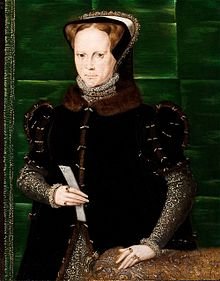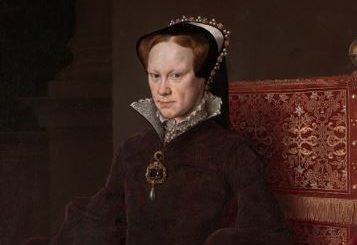Timeline: Mary I of England (“Bloody Mary”)
Worldhistoryedu.com digs deep into the major events and crucial facts about the life, reign and dark legacy of Mary I of England – one of England’s bloodiest and most ruthless rulers.
Fast Facts: Mary I of England
Born: Mary Tudor
Date of Birth: February 18, 1516
Place of Birth: Greenwich (close to London, England)
Date of Death: November 17, 1558
Place of Death: London, England
Parents: Henry VIII and Catherine of Aragon
Siblings: Edward VI, Elizabeth I
Spouse: Philip II of Spain (son of Holy Roman Emperor Charles V) – married in 1554
Children: None
Religion: Roman Catholicism
Coronation: October 1, 1553
Reign: 1553- 1558
Successor: Queen Elizabeth I
Predecessor: Edward VI
Title: Queen of England, France and Ireland, Defender of the Faith, and the Church of England and of Ireland on Earth Supreme Head
House: Tudor
Most known for: Her violent persecution of Protestants in England in a bid to bring back Roman Catholicism to England
Nicknames: Bloody Mary
Other titles: Queen consort of Spain (1556-1558)
READ MORE: The Act of Supremacy and How the English Monarch became the Head of the Church of England
Timeline: Bloody Mary of England
1516: Princess Mary is born on February 18 at the Palace of Placentia, Greenwich, England
1518: Arrangements are made for her to marry Francis, the son of King Francis I of France; the marriage agreement failed to materialize later
1522: Her father, King Henry VIII, tries to marry her off to her 22-year-old first cousin, Holy Roman Emperor Charles V
1517: Countess of Salisbury is made Mary’s governess
1525: A nine-year-old Mary is sent to Wales, where she presides over the Council of Wales and the Marches; she is also given her own court at Ludlow Castle
1525: Invested with the title of Princess of Wales
1528: Her father’s courtiers and advisors float James V of Scotland as a possible future husband
Read More: 10 Most Influential Scottish Monarchs and their Reigns
1533: Her father proceeds to marry Anne Boleyn as her mother’s marriage crumbles and she is sent packing to live in the countryside
May 1533: The Archbishop of Canterbury Thomas Cranmer officially nullifies her parents’ marriage; her father goes on to break away from Rome and appoints himself the head of the Church of England
Read More: How the English Monarch became Supreme Head of the Church of England
December 1533: Mary becomes the lady-in-waiting to Anne Boleyn’s infant daughter Princess Elizabeth (later Queen Elizabeth I)
1534: All her titles are stripped away from her; she is now called “The Lady Mary” as her mother is called Dowager Princess of Wales (a reference to her being the widow of Henry VIII’s late brother, Prince Arthur)
1536: Mary is shattered upon hearing the news of her mother’s death
1536: Anne Boleyn is executed on charges of adultery and treason
1536: Her father marries Jane Seymour, who then persuades Mary to make peace with her father
1537: Mary becomes the godmother of her infant half-brother Edward (later Edward VI)
1540: Her father marries Anne of Cleves, the sister of the Duke of Cleves; Anne is Henry’s fourth wife; the marriage, however, is annulled in less than a year
Read More: Biographies of the Six Wives of King Henry VIII of England
July 28, 1540: Henry’s chief minister Thomas Cromwell is executed on charges of treason and attempt to marry Princess Mary
July 28, 1540: Mary’s father, 49, proceeds to marry his fifth wife, Catherine Howard, a teenager. Catherine is the daughter of Lord Edmund Howard and Joyce Culpeper. Catherine is also the cousin of Anne Boleyn
1541: Her governess, the Countess of Salisbury, is executed on the charge of treason
February 13, 1542: Catherine Howard, Henry VIII’s wife, is executed on flimsy charges of treason and adultery
July 12, 1543: At Hampton Court Palace, her father marries (to Catherine Parr) for the sixth time; both Mary and Elizabeth’s succession rights are restored under the Act of Succession 1544
1547: Her father dies and the crown passes to her nine-year-old brother Edward; in spite of her brother’s strong affinity for Protestant faith, Mary remains in defiance and continues holding Catholic mass in her private residence.
July 6, 1553: King Edward VI dies at the age of 15. The king, who died of tuberculosis, removes both Mary and Elizabeth from the line of succession, favoring his cousin Lady Jane Grey.
Before Edward VI died, Mary escaped to East Anglia as she feared for her life.
July 10, 1553: Lady Jane Grey is crowned queen of England
July 19, 1553: Mary raises an army and matches from Suffolk and overthrows Lady Jane Grey. The latter is imprisoned, along with several members of the Dudley family.
Read More:
August 3, 1553: Mary walks into London to a rousing welcome from the crowd who lined the streets to greet her
1554: Sir Thomas Wyatt leads a rebellion (the Wyatt’s rebellion) against Mary’s rule and her impending marriage to Philip II of Spain
After crushing Wyatt’s rebellion, Mary executes Wyatt and all the conspirators, which included Lady Jane Grey, her father (the Duke of Suffolk), and her husband (Guildford Dudley)
Her half-sister Elizabeth is imprisoned at the Tower of London following the rebellion.
July 25, 1554: Mary gets married to Philip II of Spain at the Winchester Cathedral
Read More: Philip II of Spain and the Spanish Armada that attempted to invade England in the summer of 1588
September 1554: As a result of strong desire to conceive, Mary goes through what was most likely a false pregnancy
The stress from her false pregnancy makes her reign even more crazed, as she revives the Heresy Acts and goes on a killing spree. It has been estimated that she burnt more than 300 people at the stake.
1555: She forces Thomas Cranmer, the Archbishop of Canterbury, to recant his Protestant-leaning faith and embrace the Rome’s authority as the Head of the English Church.
The Catholic Mary I reversed her father’s decision – the supremacy (i.e. the First Act of Supremacy 1534), in which the English monarch was considered sovereign over the Church within his realm.
March 1556: In spite of his recantation, Cranmer suffers the same fate as other Protestants; he was burnt at the stake. Before his death, he recanted his earlier confessions and stayed true to the principles of the English Reformation.
With charred bodies piling up in the hundreds, there were fears that her subjects would revolt against her rule. And the more Mary pushed, the more anti-Catholic and anti-Spain the English folks became. Thus she made her victims (i.e. those who stuck with the principles of the English Reformation) martyrs.
January 1558: After she is persuaded to join in a war against France, Mary is humiliated as she loses Calais to French Forces.
1557: Mary goes through another false pregnancy; she even makes plans for her husband to be regent.
November 17, 1558: At St James’s Palace, Queen Mary I passes away at the age of 42; she was succeeded by her Protestant half-sister Elizabeth.
In 1558, during the reign of Queen Elizabeth I, the Act of Supremacy was passed by the first Elizabethan Parliament. This act declared Elizabeth the Supreme Governor of the Church of England, and established the Oath of Supremacy, which required all public officials and clergymen to swear allegiance to the English monarch as the head of both the Church and the state.
Other interesting facts about Bloody Mary
- Her godparents were Lord Chancellor Thomas Wolsey, Catherine of York, Countess of Devon, Agnes Howard, Duchess of Norfolk.
- At just two years of age, plans were made to betroth her to Francis, the son of King Francis I of France. The marriage plans, which were made for purely political reasons, failed to go through after three years.
- Another disastrous pairing came when she was six as she was arranged to marry her 22-year-old first cousin, Holy Roman Emperor Charles V. Subsequently, there was the Dauphin’s father – King Francis I. Like the two previous arrangements, this one too failed. So did attempts to marry her off to Francis’ second son Henry, Duke of Orleans.
- The Bible verse that Henry VIII used as his foundation for his marriage annulment was Leviticus 20:21. The verse states that it is a sin for someone to marry the widow of his brother. On the other hand, her mother, Catherine, responded by saying that her marriage to Arthur was not consummated. She believed it was invalid as Pope Julius II annulled it in order to pave the way for Henry and Catherine to tie the knot.
- Mary’s cousin, Charles V, imprisoned Pope Clement VII and prevented him from annulling Henry VIII’s marriage to Catherine.
- Beginning around her mid-teens, Mary suffered severely from depression and other forms of sickness. The sickness was exacerbated by parents’ problem-fraught marriage as she was prevented from seeing her mother. Even when her mother was seriously ill, she was still prevented from seeing her.
- In 1536, Lord Hussey (Mary’s former chamberlain) led a rebellion (the Pilgrimage of Grace) against Henry VIII. Hussey’s rebellion, which started in the north of England, was quickly and brutally crushed by the king.
- During Edward VI’s rule, the Act of Uniformity 1549 demanded that all church services in the country conform to Protestant doctrine. Mary’s refusal to conform to Protestant rites almost got her executed. Perhaps, she was able to keep her head because of the sheer amount of influence her Catholic cousin Charles V (Holy Roman Emperor) had across Europe.
- Her marriage to Philip II of Spain made her Queen of the Spanish Kingdoms and all its realms.
- She initially began her reign in a very peaceful manner; she proclaimed that every English man and woman would be allowed to practice whatever faith he/she desired. A few months into her reign, she had made a complete U-turn; she started arresting influential Protestant clergymen and followers. She even apprehended Thomas Cranmer, the former Archbishop of Canterbury. She also declared that her parents’ marriage was very valid before quickly moving to repeal all her predecessors’ Protestant laws. She also seized all the properties that were bestowed upon the Protestants during Henry VIII and Edward VI’s reigns.
- Much of what Mary did during her reign was influenced by her husband, Philip II of Spain. Her persecution of Protestants forced many of them to go into exile, including John Foxe – the famous author who wrote Actes and Monuments (also known as Foxe’s Book of Martyrs).
- Mary believed that her false pregnancy (as well as her inability to conceive) was God’s way of punishing her for her inability to rid England off heretics (i.e. Protestants).
- Mary I of England likely died of either uterine cancer or ovarian cysts. In her will, she stated that she be buried next to her mother, Catherine of Aragon; however, she was laid to rest in Westminster Abbey on 14 December, 1558. She would share this place with her half-sister Elizabeth I.
READ MORE: Why Did Parliament Wage War Against the Monarchy in the 17th Century?





























